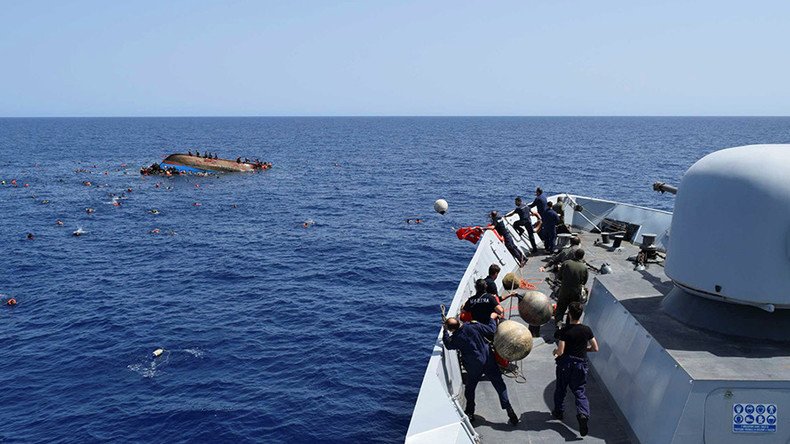‘Shockingly large’ number of refugees in Med pushes German Navy to limits – report

Rescuing migrant boats in the Mediterranean may soon push the German Navy’s task force to its limits due to a “shockingly” large number of people on Libya’s shores eager to reach Italy across the sea, the military has warned.
The number of refugees trying to reach Europe across the Mediterranean is increasing rapidly, to the extent that the German maritime task force taking part in the EU’s ‘Operation Sophia’ rescue mission will soon be on the edge of its capabilities, according to Die Zeit newspaper.
“We’re a bit frightened about the large number of those who are now coming from Libya, whenever the weather is stable,” a spokesperson for the Bundeswehr’s overseas missions command told the newspaper.
#opSophia the @Armada_esp frigate #ReinaSofia now rescuing these #migrants spotted by #SW3Merlin3 aircraft... pic.twitter.com/TZOngzwF7v
— EUNAVFOR MED OHQ (@EUNAVFORMED_OHQ) May 26, 2016
According to the UN’s International Organization for Migration Refugee Agency (IOM), an estimated 190,000 people have crossed the Mediterranean in 2016. Of them, nearly 156,000 came to Greece and 34,000 to Italy, with 1,375 people considered missing or dead.
The new Libyan government is making efforts to contribute to Operation Sophia, the spokesperson said, including by deploying coast guard vessels to rescue migrant boats in distress and stop the smugglers.
“This is only a drop in the ocean, but, at any rate, at least something is [being done],” he said.
The German Navy has taken part in Operation Sophia since June 2015, and is tasked with monitoring refugee smuggling routes and rescuing the shipwrecked. Since the start of their deployment off Italian shores, German sailors have rescued over 14,000 migrants, according to a Bundeswehr statement.
Those rescued came “almost exclusively” from the countries of Sub-Saharan Africa, and were trying to use Libya as a transit point on their way to Europe.
Interaktive Grafik zu Veränderungen der #Fluchtrouten: Neue Balkanroute und das Mittelmeer. https://t.co/VHyj992J85pic.twitter.com/1L6mSM9Q15
— Pro Asyl (@ProAsyl) May 13, 2016
The notorious ‘Balkan route’, the main gateway to Europe, has been closed for refugees under the EU-Turkey deal, and some media reports have suggested that the Egyptian and Libyan coastlines could serve the same purpose. Earlier in March, Die Zeit cited sources in Western intelligence services as saying that “150,000 to 200,000 refugees” have entered Libya and are keen to bypass the Balkan route.
The newspaper report also stated that “tens of thousands of Syrians, Iraqis and Afghans” gathered near the Egyptian city of Alexandria and all along the Libya’s coast to embark in inflatable boats owned by smugglers.
READ MORE: Greece, Italy and Malta close off airspace to Libyans amid NATO operation rumors
Libya, which has effectively been on the brink of turning into a failed state since the 2011 NATO intervention, could see a new wave of instability in the coming months. Earlier on Thursday, Greek authorities issued a Notice to Airmen (NOTAM) banning Libyan flights from entering Flight Information Region Athens starting Thursday, the Kathimerini newspaper reported.
Rumors of a looming NATO operation in the country, which could trigger a new influx of refugees from Libya itself, have also been fuelled by NATO Secretary General Jens Stoltenberg, who said that the bloc “stood ready” to act at the request of the country’s new government in Tripoli.













